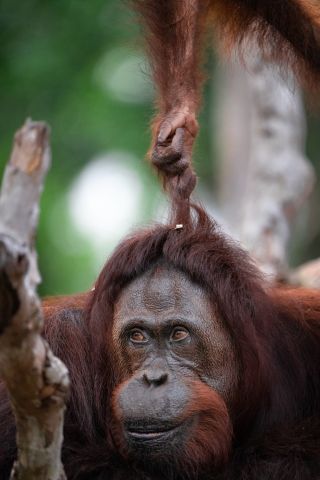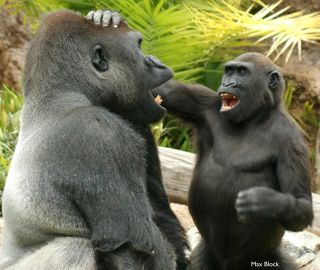Humor
Teasing Apes Suggest Humor Has Deep Evolutionary Roots
Great apes engage in playful teasing, a precursor to joking behavior.
Posted February 15, 2024 Reviewed by Gary Drevitch
Key points
- Scientists studied 142 examples of playful teasing from video of four species of zoo-housed great apes.
- Like joking, ape teasing is intentional, provocative, persistent, and includes elements of surprise and play.
- Teasing requires sophisticated socio-cognitive abilities and may be a precursor to joking behavior in humans.
- The cognitive prerequisites for teasing may have evolved in a common ancestor of humans and apes.

Are humans the only animals with a mischievous sense of humor? Where did our ability to joke with one another come from? In a new study, a team of cognitive biologists and primatologists report evidence of playful teasing in four great ape species: orangutans, chimpanzees, bonobos, and gorillas. These findings suggest that the cognitive building blocks of humor were likely inherited by apes and humans from our last common ancestor at least 13 million years ago.
Provocative and Playful
Joking may seem simple, but it requires complex cognitive abilities, including understanding social norms, appreciating the violation of others’ expectations, and anticipating the responses of others.
Playful teasing shares many of these features and may be a cognitive precursor to joking. Erica Cartmill of Indiana University, senior author of the study, says that playful teasing is a distinct behavior somewhat in between aggression and play, and it is intended to provoke a reaction: “It’s behavior that is annoying, but in a way that is playful and largely tolerated, rather than aggressive. Playful teasing actions are designed to engage with another in a loving way, but at the same time be a little bit irritating.”
These behaviors are familiar to humans of all ages: Babies as young as eight months old engage in simple forms of playful teasing like offering and withdrawing objects, breaking social norms, and disrupting others’ activities.
For the new study, Cartmill teamed with scientists from the University of California Los Angeles, the Max Planck Institute of Animal Behavior, and the University of California San Diego to look for playful teasing in humans’ closest relatives: the great apes. The team developed a coding system and criteria to identify playful teasing and measure the behavior of both teaser and target during an interaction. From 75 hours of video of zoo-housed orangutans, chimpanzees, bonobos, and gorillas, the researchers found 142 strong examples of teasing.
Going Ape
Among the four great ape species, Cartmill and colleagues identified 18 distinct teasing behaviors. These included actions like poking, pulling on hair, offering and withdrawing an object, tickling, hindering activity, and violating personal space. (Watch a video of some of the behaviors here.)

“We found many examples of behaviors that were performed in ways to provoke a reaction from another ape, but within social relationships that were fundamentally positive,” says Cartmill. “None of these behaviors resulted in aggression or ostracizing, and none of them escalated into bullying.”
Cartmill and colleagues noted similarities between playful teasing in apes and children. Across species, teasing involves one-sided provocation, repetition, and elements of surprise. And teasers, whether ape or child, often look at their target’s face, presumably to gauge their response to the teasing.
Playful teasing behaviors in apes had some key features in common:
- They were provocative. Teasers led the interactions by directing hard-to-ignore behaviors at their targets.
- They were intentional. Teasers approached specific targets and persisted when they were ignored, by either repeating or increasing the intensity of the behavior or switching to a different behavior.
- They were playful, but not “play.” While teasing is a playful activity, it differs from play. Teasing was more one-sided than play, and apes rarely used play signals when teasing.
- They occurred in relaxed contexts. Teasing mainly occurred when apes were relaxed, suggesting that it may happen during moments of neutrality or boredom.
The Roots of Joking
Cartmill hopes that this paper, the first to systematically study playful teasing in apes, will inspire more research on the behavior. According to the researchers, a better understanding of teasing in other species may shed light on the evolution of humor. The presence of playful teasing in all four great apes, and its similarities to teasing and joking in human infants, suggest that the cognitive prerequisites of the behavior may have existed in our last common ancestor, at least 13 million years ago.
Future studies could also help determine the function or functions of playful teasing. One possibility is that it reinforces and builds relationships, as well as broadcasting the strength of those relationships to others. “For example, if you are out with a close friend, you may playfully call them a name or otherwise tease them in front of other people, but they’re not going to react negatively,” says Cartmill. “That speaks to the strength of that relationship and the trust between you two.”
.jpg?itok=YQy9RyKb)
Playful teasing may also help juveniles learn about social relationships and develop social skills. Humans and apes live in complicated and ever-changing social groups. Learning how to navigate this landscape is necessary for success within the group. Juveniles may use playful teasing to practice their ability to predict what others will do.
“If you’re a social animal, understanding how others will respond to your behavior is an important skill,” says Cartmill. “You have to monitor their behavior and know what your relationship is like in order to know how far to push.”
Finally, Cartmill says this study highlights the similarities we share with our closest relatives, the great apes.
“Playful teasing is a behavior we absolutely see in humans, but it is not because we are different, but because humans are fundamentally the same, in many ways, as other social animals.”
References
Laumer IB, Winkler SL, Rossano F, Cartmill EA. 2024 Spontaneous playful teasing in four great ape species. Proc. R. Soc. B 291: 20232345. Doi: 10.1098/rspb.2023.2345.




